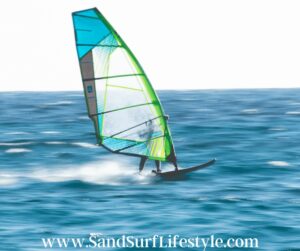 As the summer heat starts to descend on our area beaches, many are looking for new ways to enjoy the sun, sand, and waves. There are plenty of different sports to try—sailing, tubing, wake sports, board sports, bodysurfing, diving—so how do you pick just one?
As the summer heat starts to descend on our area beaches, many are looking for new ways to enjoy the sun, sand, and waves. There are plenty of different sports to try—sailing, tubing, wake sports, board sports, bodysurfing, diving—so how do you pick just one?
There are plenty of board sports to try, even for beginners. So when looking at the benefits of kitesurfing versus windsurfing, it’s hard to pick which one is best for you.
Kitesurfing may be easier to learn, but what are the differences between each sport? Read on to find out.
What is Kitesurfing?
Kitesurfing, also known as kiteboarding, is considered an extreme sport where the rider, or kiter, uses wind and a large kite to be pulled along the water. It can also be done on land or in snow. The sport combines different parts of surfing, windsurfing, wakeboarding, paragliding, and other extreme sports in the same category.
While it was invented in the late 1970s, kitesurfing began gaining popularity in the 1980s, as new patents were developed to add other forms of mobility—roller skates, ice skates, and canoes, included.
The highest kite jump record currently sits at 28.6 meters with an airtime of 8.5 seconds, held by Nick Jacobsen and achieved in Cape Town, South Africa. Speed records have also been achieved, hitting over 50 knots.
When kitesurfing on water, surfers use a kiteboard, which is like a wakeboard, or a small surfboard, typically with foot straps and bindings.
To learn how to kitesurf, a new surfer will need a power kite. There are two different types—leading edge inflatables and foil kites. The leading edge inflatable kite is made with an inflatable plastic bladder to give it its shape, along with keeping it afloat if it is dropped in the water. Made of ripstop polyester, they are a popular choice among kitesurfers. A foil kite, made out of nylon, has air cells inside it similar to a paraglider. These do not need to be inflated like the leading edge inflatable kite.
New kitesurfers will also need flying lines and a control bar to properly control the kite they are using, a kiteboard that serves the stylistic purpose—most use twintip boards—and a wetsuit. Kitesurfers are encouraged to also have a safety hook knife, a helmet, and other safety devices.
Lessons on kitesurfing typically include learning to fly a kite on land, flying a kite in the water, and then getting up onto the board, according to RedBull.com. The energy drink company supports one of the largest competitions of kitesurfing in the world, The Red Bull King of the Air competition, which judges on jump height, style, and tricks.
As you learn, there are several different kiteboarding styles as well—freeride is the most popular and easiest out of the techniques, encouraging surfers to just have fun. Twintip boards are used mainly for this style.
Freestyle is also a popular technique and is mostly used for competition—the main difference between freestyle and freeride is that freestyle allows surfers to do tricks while going airborne. Kitesurfers can also ride the waves like a traditional surfer, use wakes similar to wakeboarding, or even complete a course.
In terms of safety, power kites can go out of control in bad wind and weather. Understanding whether when going out to kitesurf is integral to safety. Having the right safety equipment and understanding the area is also important to a kitesurfer.
What is windsurfing?
 Windsurfing is not always considered an extreme sport—that is the first major difference between the two. It is a surface water sport that combines aspects of both surfing and sailing. It is most popular in areas with flat water, surfers use a board and attached sail to surf and maintain balance.
Windsurfing is not always considered an extreme sport—that is the first major difference between the two. It is a surface water sport that combines aspects of both surfing and sailing. It is most popular in areas with flat water, surfers use a board and attached sail to surf and maintain balance.
When windsurfing, surfers use either shortboards or longboards. Shortboards are used for more planing, or when the surfer and board move based on its speed rather than its buoyancy. Longboards are used when the winds are lighter or if the surfer is course racing. Boards also depend on what kind of style the surfer is doing, much like the different boards of the kitesurfer.
Instead of a kite, though, the windsurfer uses a sail that is attached to a board. The larger the sail, the stronger the surfer must be to control it. Similar safety measures are encouraged.
Starting in the 1960s, it gained popularity through the 1980s and was recognized as a demonstration sport for the Olympics in 1984. It was based on the idea of Polynesians riding the wind, creating equipment similar to theirs as developments were made in the sport.
There is also such a thing as indoor windsurfing—competitions are held during winter, and large fans are lined up along a pool to allow surfers to compete in slalom and ramp jumping competitions.
Windsurfing can be as high key or lowkey as the surfer desires—it has its own safety issues and dangers. Turning it into an extreme sport requires more jumps, which are possible when windsurfing. Much like kitesurfing, there are different styles associated with windsurfing. Wave riding is similar to surfing, but a rider can use the sail to gain extra speed while riding the wave. Along with that, surfers can wave jump—performing tricks much like a traditional surfer.
Surfers can also make the sport more extreme by participating in big wave riding, where surfers attempt to ride waves over 30 feet high. The best location for these waves is Pe’ahi, Maui, Hawaii, also known as Jaws, where the surf break allows for large waves sought after by all types of surfers.
More experienced surfers can try storm riding—like the Red Bull kitesurfing competition, the company also holds the Red Bull Storm Chase event, which is held only when a storm is forecasted to have over 60-knot winds, or around 70 miles per hour, with waves over 20 feet. Attempting to surf in a storm is extremely dangerous and should not be attempted by beginners.
There are also records associated with windsurfing, including a speed sailing record of 53.27 knots.
Find out the 2021 cost breakdown of kitesurfing here.
Kitesurfing vs. Windsurfing: What’s the Difference?
Because of the nature of the sport, windsurfing is where most beginners start. The equipment is easier to use and takes less instruction. When shifting to kitesurfing, there is more need to have control over the equipment and keep it aloft. It’s the same with the board—in kitesurfing, it’s harder to get started, while in windsurfing, the board is already floating when the surfer gets on.
 While the gear is similar, it is much easier to carry around kitesurfing gear than windsurfing gear. The cost for the equipment is still around the same, with new windsurfing gear coming in a little more expensive than the kitesurfing counterparts.
While the gear is similar, it is much easier to carry around kitesurfing gear than windsurfing gear. The cost for the equipment is still around the same, with new windsurfing gear coming in a little more expensive than the kitesurfing counterparts.
One major difference with the gear, though, is the view. When windsurfing, a surfer’s rig—mainly, the sail—blocks about half the view as they sail. Kitesurfing doesn’t have that problem, allowing surfers a full view of nature.
Another gear difference is the response—a kite has longer lines, so the response takes time, while a surfer controls the sail and it responds immediately.
Learning each sport is also different. When learning how to kitesurf, it takes several lessons before the surfer gets into the water and onto the board. Windsurfing, though, gets surfers out onto the water typically in the first lesson.
But it doesn’t always stay that way. Kitesurfers, after a few hours of lessons, can learn techniques and how to achieve speeds that a windsurfer has known for years. Surfers who expect fast results should try kitesurfing, while patient surfers should try windsurfing.
Windsurfing takes up more physical space when it comes to gear and focuses less on acrobatics than kitesurfing does. Windsurfing takes more strength, while kitesurfing takes higher winds.
When riding, it’s much easier to change direction when kitesurfing. Using twintip boards means that surfers can simply switch sides, making the front of the board the back and vice versa. In windsurfing, one must turn the rig around to catch the wind again and change direction.
Kitesurfers have more ability to create jumps and get airtime. While it is not impossible to get air while windsurfing, the lightweight construction of the kitesurfing setup allows for more tricks to be performed.
Upon the advent of kitesurfing, windsurfing was considered a dying sport, having been removed from the 2024 Olympics. Its dependence on specific weather, the cost, the need for space for equipment, and the length of time to learn have all made it less popular.
Considering both sports rely on the power of wind, both need the same sort of conditions.
 Both sports also require the same focus on safety. Learning how to properly perform either sport is essential, along with using the proper gear. Surfers also tend to get hurt more when kitesurfing, although the severity remains the same, according to a study published on the National Center for Biotechnology Information website.
Both sports also require the same focus on safety. Learning how to properly perform either sport is essential, along with using the proper gear. Surfers also tend to get hurt more when kitesurfing, although the severity remains the same, according to a study published on the National Center for Biotechnology Information website.
Kitesurfing tends to be less physically challenging, as most of the work relies on the wind. Windsurfing, on the other hand, takes more strength and stamina to control the sail.
Kitesurfing typically requires surfers to have a second person to help land the kite, where in windsurfing, it can be done independently.
Kitesurfing or Windsurfing: Which one is easier?
As you’ve read, both sports have their merits. While windsurfing is easier to start, kitesurfing has more development for intermediate and expert surfers. Depending on what a surfer’s goal is—gradual improvement or a need for safety and speed—they will have to choose between windsurfing and kitesurfing.
When it comes down to it, kitesurfing is easier. Surfers require less space for their gear and less beginner’s training, along with less physical strength. Kitesurfing also provides results much faster than windsurfing.
Whichever you choose, make sure you find a qualified instructor in your area that can teach you how to surf in similar conditions to your closest location. The biggest difference when choosing to kitesurf over windsurfing is safety—while it’s easier, make sure you consider the fact that windsurfing is considered safer.
Please note: This blog post is for educational purposes only and does not constitute legal or medical advice. Please consult a legal expert or medical professional to address your specific needs.

